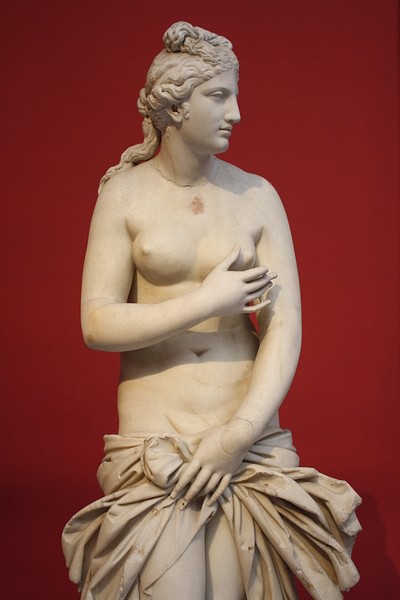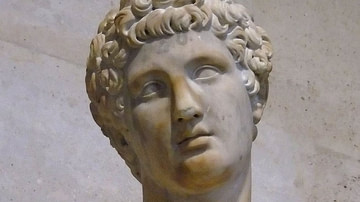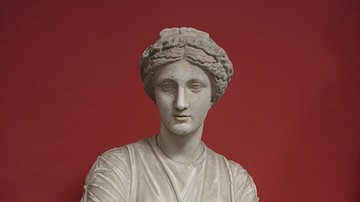
Aphrodite was the ancient Greek goddess of love, beauty, desire, and all aspects of sexuality. She could entice both gods and men into illicit affairs with her beauty and whispered sweet nothings. Aphrodite was born near Cyprus from the severed genitalia of the sky god Uranus. Aphrodite had a wider significance than the traditional view as a mere goddess of love.
Worshipped by men, women, and city-state officials, Aphrodite also played a role in the commerce, warfare, and politics of ancient Greek cities. In addition, Aphrodite was honoured as a protector of those who travelled by sea and, less surprisingly, courtesans and prostitutes. The goddess' Roman equivalent was Venus.
Aphrodite's Birth from Uranus
In mythology, the goddess was born when Cronos castrated his father Uranus (Ouranos) with a sickle and cast the genitalia into the sea from where Aphrodite appeared amidst the resulting foam (aphros). In other versions, she is the daughter of Zeus and Dione, the Titaness. Hesiod recounts the first version and Homer the second, and the Greeks were troubled by such an obvious contradiction from their two great myth-makers. Indeed, Plato even came up with a theory to reconcile the two ancient authors, suggesting that there were actually two different goddesses of the same name, one to represent (in his view) the higher love between men and another to represent the love between men and women. Plato called these the 'Heavenly Aphrodite' and 'Pandemic Aphrodite' respectively.
Believed to have been born close to Cyprus, Aphrodite was especially worshipped in Paphos on the island – a geographic location which hints at her eastern origins as a fertility goddess and possible evolution from the Phoenician goddess Astarte or the Near Eastern goddess Inanna (Ishtar). The two areas of Greece and the Near East witnessed intense cultural exchange prior to the 8th-century BCE Archaic Period, and it is perhaps significant that the 5th-century BCE Greek historian Herodotus states that the most ancient cult site to Aphrodite was at Ascalon in Syria. It is also possible that the goddess derived from an entirely local Cypriot deity. The strong association with the island is evidenced in her common name, Cypris, meaning 'of Cyprus'.
More certain than her origins is that the goddess' birth and consequent association with the sea was manifested in the location of many coastal sanctuaries dedicated to her and several common epithets such as Aphrodite Pontia ('of the deep sea') and Aphrodite Euploia ('of the fair voyage'). Aphrodite was associated with the brightest planet, Venus, and this, always a valuable navigational aid, may be another connection with ancient mariners.
Hephaistos & Ares
Compelled by Hera to marry the not-so-great catch of Hephaistos, the lame god of fire and crafts, Aphrodite was less than faithful, having notorious affairs with the gods Ares, Hermes, and Dionysos. The fling with Ares was perhaps the most shocking of the many episodes of infidelity that occurred amongst the Olympian Gods. Hephaistos, a fiendishly clever designer and engineer, manufactured a special golden bed to entrap his wife. When Aphrodite and Ares were at their most passionate, the bed sprang forth golden chains which locked the naked gods in their illicit embrace. Their embarrassment was made worse when Helios the sun god shone down his bright light upon the couple so that all the Olympians could get a good look at the disgrace. When finally freed, Ares fled to Thrace and Aphrodite back to Cyprus.
Who are Aphrodite's Children?
Aphrodite was considered the mother of Eros, Harmonia (with Ares), the Trojan hero Aeneas (with Anchises), Eryx the king of Sicily (with Butes the Argonaut) and, with either Dionysos or Adonis, Priapus (a gardener with huge genitals). The goddess had a large retinue of lesser deities such as Hebe (goddess of youth), the Hours, Dike, Eirene, Themis, the Graces, Aglaia, Euphrosyne, Thaleia, Eunomia, Daidia, Eudaimonia, Himeros (Desire) and Peitho (Persuasion).
Aphrodite often represented unity and concord, as well as mixis or 'mingling', and this may explain the goddess' wide range of associations such as warfare and politics, arenas where disparate groups had to work together as one. She was specifically the protectress of city magistrates, too.
Aphrodite & The Trojan War
In mythology, Aphrodite is cited as partly responsible for the Trojan War. At the wedding of Peleus and Thetis, Eris (goddess of strife) offered a golden apple for the most beautiful goddess. Hera, Athena, and Aphrodite vied for the honour, and Zeus appointed the Trojan prince Paris as judge. To influence his decision, Athena promised him strength and invincibility, Hera offered the regions of Asia and Europe, and Aphrodite offered the most beautiful woman in the world. Paris chose Aphrodite and so the victorious goddess gave him fair Helen of Sparta. However, as she was already the wife of Menelaos, Paris's abduction of Helen provoked the Spartan king to enlist the assistance of his brother Agamemnon and send an expedition to Troy to take back Helen.
Hesiod describes the goddess as 'quick-glancing', 'foam-born', 'smile-loving', and most often as 'golden Aphrodite'. Similarly, in Homer's description of the Trojan War in the Iliad, she is described as 'golden' and 'smiling' and supports the Trojans in the war. In notable episodes, Aphrodite protects her son Aeneas from Diomedes and saves the hapless Paris from the wrath of Menelaos.

Aphrodite Falls in Love with Adonis
One of the goddess' most famous flings was with the beautiful Adonis. Aphrodite kept the youth safely in a chest guarded by Persephone, but the latter fell in love with him too and would not give him back to the goddess of love. Zeus was obliged to intervene, and he ruled that Adonis should spend four months of the year with each lady (and fourth months rest on his own). Tragically killed in a hunting accident, the impossibly handsome youth was transformed into a flower without scent. Aphrodite was distraught at her loss, and her grief was commemorated in a cult, the annual highlight of which was a women-only festival, the Adonia.
How is Aphrodite Represented in Art?
The birth of Aphrodite from the sea (perhaps most famously depicted on the throne base of the great statue of Zeus at Olympia) and the judgment of Paris were popular subjects in ancient Greek art. The goddess is often identified with one or more of the following: a mirror, an apple, a myrtle wreath, a sacred bird or dove, a sceptre, and a flower. On occasion, she is also depicted riding a swan or goose. She is usually clothed in Archaic and Classical art and wears an elaborately embroidered band or girdle across her chest which held her magic powers of love, desire, and seductive allurement. It is only later (from the 4th century BCE) that she is depicted naked or semi-naked, such as in the Venus de Milo marble statue. The story of Aphrodite continued to interest artists, especially during the Renaissance, and she was perhaps most famously captured in Sandro Botticelli's 1486 painting The Birth of Venus, now in the Uffizi Gallery of Florence.






